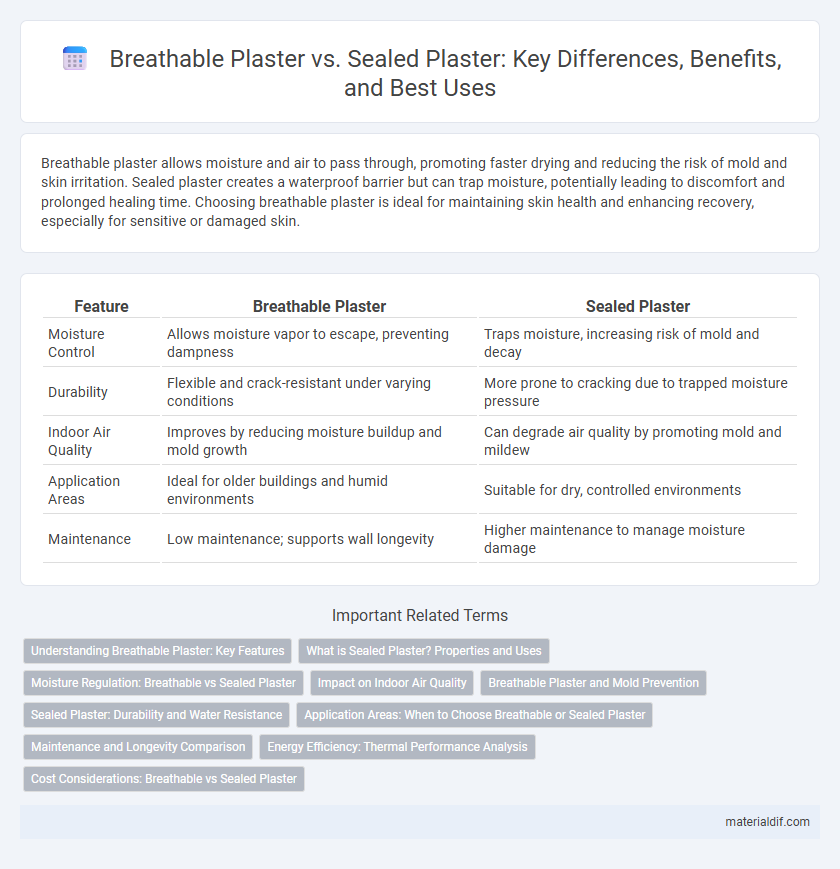Breathable plaster allows moisture and air to pass through, promoting faster drying and reducing the risk of mold and skin irritation. Sealed plaster creates a waterproof barrier but can trap moisture, potentially leading to discomfort and prolonged healing time. Choosing breathable plaster is ideal for maintaining skin health and enhancing recovery, especially for sensitive or damaged skin.
Table of Comparison
| Feature | Breathable Plaster | Sealed Plaster |
|---|---|---|
| Moisture Control | Allows moisture vapor to escape, preventing dampness | Traps moisture, increasing risk of mold and decay |
| Durability | Flexible and crack-resistant under varying conditions | More prone to cracking due to trapped moisture pressure |
| Indoor Air Quality | Improves by reducing moisture buildup and mold growth | Can degrade air quality by promoting mold and mildew |
| Application Areas | Ideal for older buildings and humid environments | Suitable for dry, controlled environments |
| Maintenance | Low maintenance; supports wall longevity | Higher maintenance to manage moisture damage |
Understanding Breathable Plaster: Key Features
Breathable plaster is designed to allow moisture vapor to pass through its surface, preventing the buildup of dampness within the walls and reducing the risk of mold growth. This type of plaster typically contains natural materials such as lime or clay, which contribute to its permeability and ability to regulate indoor humidity levels effectively. Unlike sealed plaster, breathable plaster enhances the longevity of building structures by maintaining a balanced microclimate and ensuring proper moisture management.
What is Sealed Plaster? Properties and Uses
Sealed plaster is a type of finishing material treated with a protective coating to create a non-porous surface that prevents moisture and air penetration. Its primary properties include water resistance, increased durability, and a smooth, hard finish ideal for environments requiring moisture control. Commonly used in bathrooms, kitchens, and exterior walls, sealed plaster helps protect underlying structures from humidity damage and mold growth.
Moisture Regulation: Breathable vs Sealed Plaster
Breathable plaster allows moisture vapor to escape from walls, reducing the risk of dampness and mold growth by maintaining balanced indoor humidity levels. Sealed plaster, in contrast, creates a moisture barrier that traps vapor within wall structures, potentially causing condensation and deterioration over time. Proper moisture regulation is critical for building longevity and indoor air quality, making breathable plaster a preferred choice in environments prone to humidity.
Impact on Indoor Air Quality
Breathable plaster enhances indoor air quality by allowing moisture vapor to escape, reducing the risk of mold growth and improving overall ventilation. Sealed plaster traps moisture within walls, potentially leading to dampness, mold proliferation, and degraded air quality. Choosing breathable plaster supports healthier indoor environments by maintaining balanced humidity levels and minimizing pollutants.
Breathable Plaster and Mold Prevention
Breathable plaster allows moisture vapor to escape from walls, significantly reducing the risk of mold growth by maintaining a balanced indoor humidity level. Its porous structure facilitates natural drying processes, preventing trapped moisture that typically causes mold proliferation. Using breathable plaster in damp environments is a highly effective strategy for mold prevention compared to sealed plaster, which can trap moisture and promote fungal infestations.
Sealed Plaster: Durability and Water Resistance
Sealed plaster offers superior durability and water resistance compared to breathable plaster, making it ideal for areas exposed to moisture and frequent wear. Its non-porous surface prevents water infiltration, reducing the risk of mold growth and structural damage. The enhanced protective layer of sealed plaster ensures long-lasting wall integrity in high-humidity environments.
Application Areas: When to Choose Breathable or Sealed Plaster
Breathable plaster is ideal for historic buildings, moisture-prone walls, and areas requiring humidity regulation, as it allows water vapor to escape and prevents dampness. Sealed plaster suits modern constructions and interior walls where moisture resistance and a smooth, protective surface are priorities, such as bathrooms and kitchens. Choosing breathable plaster supports preservation and health by reducing mold risk, while sealed plaster enhances durability and ease of maintenance in controlled environments.
Maintenance and Longevity Comparison
Breathable plaster reduces moisture buildup by allowing vapor to escape, which significantly minimizes the risk of mold growth and structural decay, ensuring longer-lasting surfaces with lower maintenance demands. Sealed plaster traps moisture within walls, often leading to dampness and requiring frequent repairs or reapplications to maintain integrity. Choosing breathable plaster enhances durability and reduces long-term costs by maintaining optimal wall health in varying climates.
Energy Efficiency: Thermal Performance Analysis
Breathable plaster enhances energy efficiency by allowing moisture vapor to escape, preventing condensation and reducing the risk of thermal bridging that can compromise insulation. This vapor permeability supports consistent indoor temperatures, lowering heating and cooling demands. Sealed plaster, while airtight, can trap moisture and lead to mold growth, negatively impacting thermal performance and increasing energy costs.
Cost Considerations: Breathable vs Sealed Plaster
Breathable plaster typically incurs higher upfront costs due to specialized materials that allow moisture vapor to escape, reducing long-term damage and maintenance expenses. Sealed plaster, often less expensive initially, can trap moisture leading to potential structural issues and costly repairs over time. Evaluating total lifecycle costs reveals breathable plaster as a more cost-effective solution for maintaining building integrity and preventing damp-related damage.
Breathable Plaster vs Sealed Plaster Infographic

 materialdif.com
materialdif.com